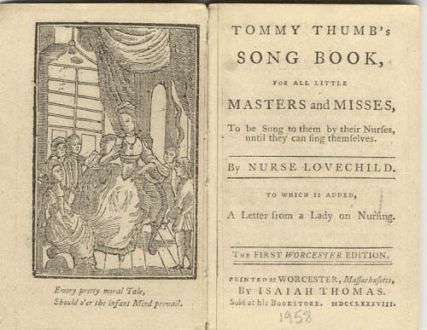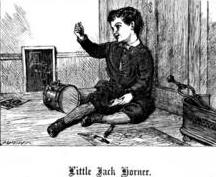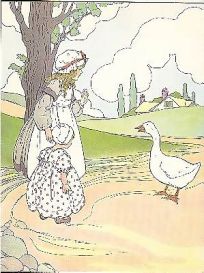NURSERY RHYMES and the Tudors
Jump to navigation
Jump to search
| Origins of The Tales of Mother Goose Many Nursery Rhymes originated in the 16th and 17th centuries The first known collection of Nursery Rhymes was 'Tommy Thumb's Song book' published in 1744. Prior to this date the content of children's poems were passed from one generation to the next by word of mouth. It was due to the lack of written material, and more importantly the lack of education for the working class, that the rhymes which we now refer to as nursery rhymes & Mother Goose tales were passed on by word of mouth. It has been suggested that the rhymes, based on the literary styles of composition, were "originally written for the gentry & copied by the ‘folk’ who worked for them, or observed them at their amusements" One can conclude that this is where the term "folk tales" originated, later to become Mother Goose tales and rhymes. |
| Little Jack Horner |
| Tudor Character(s): King Henry VIII & Richard Whiting Backstory: Circa 1530 when Henry VIII and Thomas Cromwell, Earl of Essex set about with the Dissolution of the Monasteries , it was said that Richard Whiting, the Abbot, (some accounts say Bishop) of the Cathedral at Glastonbury and Benedictine monastery, tried to bribe his way out of the situation. Glastonbury was said to be the wealthiest abbey in England owning many riches as well as an extensive array of lands and manor houses. Aging in years and with nothing to lose, Whiting conceived of a plan to hold onto the monastic estates and riches by sending the King a bribe by the way of a Christmas present, the deed to twelve manorial estates which he had hidden in a Christmas pie. Thomas Horner, steward to Richard Whiting, was sent to deliver the pie to the king, but he himself realising that the ruse would fail, delved into the pie himself and retrieved the deeds to the “plum” of the manorial estates, The Manor of Mells. Thomas Cromwell then had Whiting arrested and thrown into the Tower of London. In front of a jury of which Thomas Horner was also a member, a case was made to wit the abbot had tried to prevent the king laying hands on its rightful property. The abbot was convicted and consequently hung, drawn and quartered. It is an interesting addition to the story to note that Thomas Horner was in fact one of the jurors who condemned Abbot Whiting to death. Following the destruction of the abbey the steward, Horner moved into The Manor of Mells. Whether Horner actually ended up with the deeds to The Manor Of Mells because he stole them, or was rewarded with them for helping to convict Whiting is unknown, but records show that the very wealthy Manor of Mells became the property of Horner and his descendants who lived there well up until the 20th century, although they have claimed that the legend has no basis and in fact borders on being libelous. | Little Jack Horner sat in the corner Eating his Christmas pie. He put in his thumb and pulled out a plum And said "What a good boy am I!" |
| Little Boy Blue |
| Tudor Character(s): Cardinal Thomas Wolsey Backstory:Boy Blue is considered to be Cardinal Wolsey who was 'found asleep' by King Henry VIII and thrown from favour because he could not win the King's divorce for him. It is also pointed out that Wolsey was the son of an Ipswich butcher, and, as a boy, undoubtedly looked after his father's livestock. | 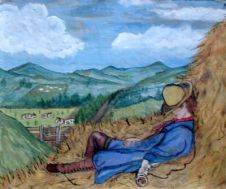 Little Boy Blue come blow your horn, The sheep's in the meadow, the cow's in the corn. But where's the boy who looks after the sheep? He's under a haystack fast asleep. Will you wake him? No, not I - for if I do, he's sure to cry |
| Mary, Mary Quite Contrary |
| Tudor Character(s): Queen Mary I or possibly Mary, Queen of Scots. Backstory: Some say the Mary alluded to in this rhyme is reputed to be Mary and the garden referred to is an allusion to graveyards which were increasing in size with those who dared to continue to adhere to the Protestant faith - Protestant martyrs. The silver bells and cockle shells were colloquialisms for instruments of torture. The 'silver bells' were thumbscrews which crushed the thumb between two hard surfaces by the tightening of a screw. The 'cockleshells' were believed to be instruments of torture which were attached to the genitals. The " Maids" or Maiden was the original guillotine! The 'maids' were a device to behead people called the Maiden. Another interpretation of this rhyme that involves Mary I involves her Spanish heritage. The 'silver bells' and 'cockle shells' represent badges that the devout wore on their pilgrimages, such as Compostella, Spain. And the 'pretty maids' were the nuns that returned to England during Mary's reign. Others say the Mary in this rhyme is Mary Queen of Scots. She was considered frivolous by some of the people of the time as she was young, pretty, Roman Catholic and had arrived from France with ‘French ways.’ She was waited on by four ladies in waiting; Mary Beaton, Mary Seaton, Mary Fleming and Mary Livingstone, it’s possible that they may be the ‘pretty maids all in a row.’ | 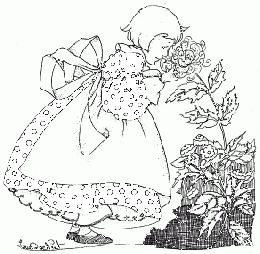 Mary, Mary quite contrary, How does your garden grow? With silver bells and cockle shells And pretty maids all in a row. |
| Three Blind Mice |
| Tudor Character (s): Mary I Backstory: It is believed that this rhyme is about Mary I of England. The "farmer's wife" in the rhyme refers to Mary I and the massive estates that she and her husband King Philip of Spain possessed. Mary I was a staunch Catholic and the " three blind mice" in the rhyme refers to three noblemen who remained true to the Protestant faith, and were ultimately convicted of conspiring against the Queen. Although she had them neither dismembered or blinded, as stated in the rhyme, she did have them burnt at the stake. from Nursery Rhymes: Lyrics and Origins | 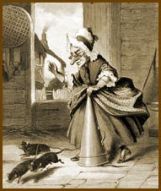 Three blind mice, three blind mice. See how they run, see how they run. They all ran after the farmer's wife, Who cut off their tails with a carving knife. Did you ever see such a thing in your life, As three blind mice? |
| Rain, Rain Go Away |
| Tudor Character (s): Elizabeth I Backstory: This rhyme refers to the attempted 1588 invasion of England by the Spanish Armada with 130 ships, and their ultimate defeat by the English navy with 34 Navy vessels and 163 armed merchant ships. The English victory was not only due to their smaller swifter vessels, but also due to the stormy weather which scattered the Spanish ships. Hence, "Rain, Rain Go Away". from Nursery Rhymes: Lyrics and Origins | 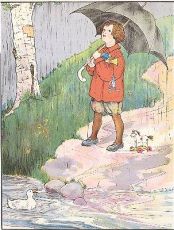 Rain, rain, go away, Come again another day. Little Johnny wants to play; Rain, rain, go to Spain, Never show your face again! |
| Old Mother Hubbard |
| Tudor Character (s): Cardinal Thomas Wolsey Backstory: The "Old Mother Hubbard" referred to in this rhyme is Cardinal Thomas Wolsey. The rhyme is about Cardinal Wolsey's attempt to try to obtain a divorce for King Henry VIII from his first wife, Katherine of Aragon, so that he could marry the Lady Anne Boleyn. In this rhyme the "doggie" refers to Henry VIII and the "bone" refers to the divorce. The "cupboard" is a reference to the Catholic Church, which Henry ultimately separated from. from Nursery Rhymes: Lyrics and Origins | 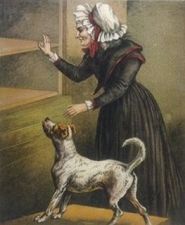 Old Mother Hubbard Went to the cupboard To get her poor doggie a bone. When she got there, The cupboard was bare, So the poor little doggie had none. |
| London Bridge is Broken Down |
| Tudor Character(s): Anne Boleyn and Lady Margaret Wyatt Backstory: In this rhyme, the "Lady Lee" that is referred to is Lady Margaret Wyatt, the sister of the poet Thomas Wyatt. When Margaret married Sir Anthony Lee of Quarrendon she became Lady Lee. As the Wyatt's and Boleyn were neighbors, Anne and Margaret were childhood friends. Later, Margaret became a lady-in-waiting to Anne and attended her until her execution on the scaffold. It is believed that this rhyme describes the rise and fall of Anne Boleyn "the gay ladye". From Nursery Rhymes: Lyrics and Origins | 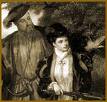 London bridge is broken down, Dance over my Lady Lee, London bridge is broken down, With a gay ladye. How shall we build it up again? Dance over my Lady Lee. How shall we build it up again? With a gay ladye. We'll build it up with gravel and stone, Dance over my Lady Lee, We'll build it up with gravel and stone, With a gay ladye. Gravel and stone will be washed away, Dance over my Lady Lee, Gravel and stone will be washed away, With a gay ladye. We'll build it up with iron and steel, Dance over my Lady Lee, We'll build it up with iron and steel, With a gay ladye. Iron and steel will bend and break, Dance over my Lady Lee, Iron and steel will bend and break, With a gay ladye. We'll build it up with silver and gold, Dance over my Lady Lee, We'll build it up with silver and gold, With a gay ladye. Silver and gold will be stolen away, Dance over my Lady Lee, Silver and gold will be stolen away, With a gay ladye. We'll set a man to watch it then, Dance over my Lady Lee, We'll set a man to watch it then, With a gay ladye. Suppose the man should fall asleep, Dance over my Lady Lee, Suppose the man should fall asleep, With a gay ladye. We'll put a pipe into his mouth, Dance over my Lady Lee, We'll put a pipe into his mouth, With a gay ladye. |
| Goosey Goosey Gander |
| I had a little nut tree |
| Tudor character(s): Queen Katherine of Aragon, King Henry VIII & Prince Arthur Tudor Backstory: The characters in the nursery rhyme 'I had a little nut tree' are believed to refer to the visit of the Royal House of Spain to King Henry VII's English court in 1506. The 'King of Spain's daughter' refers to the daughter of King Ferdinand and Queen Isabella of Spain. There were two daughters, Princess Juana and her sister Katherine of Aragon. The princess in the nursery rhyme is probably Katherine of Aragon who was betrothed to Prince Arthur, the heir to the throne of England. Arthur died and Katherine eventually married King Henry VIII. The young, beautiful daughter in this rhyme relates to the young Katherine, as a 13 year old princess and is immortalised in this old nursery rhyme . | 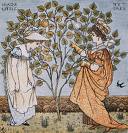 I had a little nut tree, Nothing would it bear But a silver nutmeg, And a golden pear; The King of Spain's daughter Came to visit me, And all for the sake Of my little nut tree. Her dress was made of crimson, Golden was her hair, She asked me for my nut tree And my golden pear. I said, "So fair a princess Never did I see, I'll give you all the fruit From my little nut tree. |
| Humpty Dumpty |
| Tudor Character(s): Cardinal Thomas Wolsey Backstory: The rhyme does not actually state that Humpty Dumpty is an egg. Humpty Dumpty was a colloquial term used in 15th century England to describe someone who was fat or obese - giving rise to lots of theories pertaining to the identity of Humpty Dumpty. One is that it refers to Cardinal Wolsey's downfall & Cawood Castle (Cawood, a village in Yorkshire, seven miles southwest of York) which passed to Cardinal Wolsey, who let it fall into disrepair in the early part of his career (1514 - 1530), due to his residence at the Court, devotion to temporal affairs and his neglect of his diocesan duties. King Henry VIII sent Wolsey back home in 1523 after he failed to obtain a divorce from the Pope - a huge mistake on Wolsey's part. Wolsey returned to the castle and began to restore it to its former grandeur. However, he was arrested for high treason in November, 1530 and ordered to London for trial. He left on 6 November, but took ill at Leicester and died in the Abbey there on 29 November. | 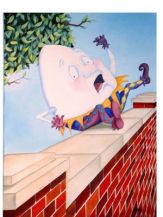 Humpty Dumpty sat on a wall. Humpty Dumpty had a great fall. All the king's horses and all the king's men Couldn't put Humpty together again. |
| |
LITERATURE:
|
